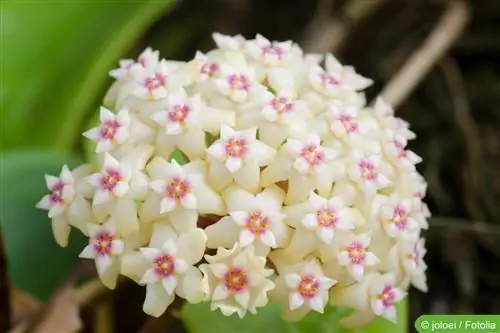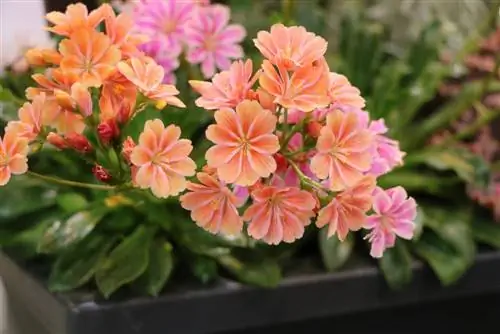- Author admin [email protected].
- Public 2023-12-17 03:39.
- Last modified 2025-06-01 06:48.
The wax or porcelain flower is a vigorously growing plant with beautiful flowers whose white is reminiscent of wax and porcelain, hence the name. The flowers grow in umbels between the thick, shiny leaves and develop an intense, sweet scent in the evening hours. Depending on the species, the shoots of the wax flower grow meters long or branched and overhanging. The plants can get very old and are then usually incredibly floriferous.
Species and names
There are several types of Hoya plant, but two that are very different in their growth can be found as houseplants:
- Hoya carnosa
- Hoya bella
The wax flower H. carnosa forms meter-long shoots that can be guided along trellises or around windows. Even without flowers, it is an attractive plant with its dark green, shiny foliage. The flesh-colored porcelain-like flower stars, with a red crown in the middle, form a dense umbel on the thickened, short side shoot. This must not be removed under any circumstances as the new inflorescences will develop there.
The porcelain flower H. bella, on the other hand, has much smaller and light green leaves. The flower umbels look similar to H. carnosa. However, they are white and have an even more expressive red crown in the middle. It is best to place this wax flower elevated on a cupboard so that you can view the flowers in all their beauty from below. With this smaller porcelain flower, the flower stalks fall off after they have faded.
In both species, the flower umbels appear from spring to autumn and last for a long time. In the evening hours, the flowers develop a sweet scent and secrete drops of nectar that make the environment a bit sticky.
Location
The wax flower loves it bright and sunny, but not full sun. Light shade is tolerated, but flower production suffers. This means: the brighter the wax flower is, the more luxuriantly and earlier it will bloom in spring. Once it has set buds, the plant must no longer be turned, otherwise they will fall off again. Care should also be taken to ensure that the flower attachment points are not injured. The porcelain flower is insensitive to dry air and hard water. During the normal growth and flowering period, room temperature and warmer are ideal for the wax flower. There are differences between the two species when it comes to overwintering. H. carnosa needs a rest period at 10-15 °C, with little watering. If this rest period is not observed, the porcelain flower will not develop any new flowers the following year. H. bella, on the other hand, loves it warmer in winter at 15-18 °C and ground warmth.
Care
Both types of porcelain flowers love nutrient-rich and loose soil. Ready-made substrates can also be loosened up with peat or fine granules. The wax flower is only transplanted when the roots fill the pot. Don't choose the new pot too big, otherwise the flower formation will stall.
- For both types, the soil should be kept moderately moist
- Avoid waterlogging at all costs
- During the rest period in winter, watering is reduced, but the soil must never dry out completely
- Some caution is required when fertilizing
- Fertilize only with low-nitrogen flowering plant fertilizer
- Fertilize no more than twice a month from April to the beginning of September
- Too much fertilizer prevents flower formation
Propagation
The wax flower can be easily propagated in spring by cuttings. To do this, cut off a young shoot from the plant, place it in fresh soil and place the pot in a light and warm place, but not in the sun. Keep moderately moist. For faster and better rooting, a perforated plastic bag can be placed over the pot.
Pests and diseases
A location that is too dark or too warm in winter causes pest infestation. Spider mites, mealy bugs and scale insects can appear on the porcelain flower. Through regular checks, these pests can be identified early on and can be combated relatively easily. A place that is too dark and over-fertilization prevent flower formation completely or partially. Dying shoots and falling leaves indicate that the plant is too wet. This causes the roots of the porcelain flower to rot.
Conclusion
-
With proper care, the wax flower becomes more and more beautiful and floriferous over the years.
The wax flower is a lush growing plant with enchanting white to flesh-colored flowers that exude an intense scent
-
The location of the plant should not be changed during flower formation
The thickened side shoot on which the flower umbels are located must not be removed; this is where the new inflorescences develop
- During the growth phase, the wax flower loves it warm; a little cooler during the winter break
- If the weather is too warm in winter, there is a risk of pest infestation
- The porcelain flower is only planted in loose and nutrient-rich soil if necessary
Quick reading tips
- The porcelain flower prefers bright locations, but no direct sun, as well as moderate humidity and preferably temperatures between 18 and 20 degrees.
- When the air is dry, there is a high risk that the porcelain flower will be attacked by lice. You can fertilize the porcelain flower every two weeks with complete fertilizer. At the beginning of winter you should stop fertilizing and no longer water too abundantly as in summer.
- The porcelain flower is a so-called ampel plant. Over the years it can develop into a powerful plant with meter-long shoots. The porcelain flower gets its name from its many small, porcelain or wax-like flowers. The older the plant, the more lush the flowers will be.
- This is a relatively undemanding plant when it comes to light. It even thrives in shady places. But the more light it gets, the sooner and more profusely it blooms. Once the porcelain flower has buds, you should avoid turning it if possible. You should exercise caution when watering the porcelain flower. It is sensitive to so-called waterlogging.
- Caution is also advised when fertilizing. Well-fertilized porcelain flowers bloom poorly. Fertilization should only be carried out from April to the end of August. Low-nitrogen flowering plant fertilizer is suitable for fertilizing. It should also be noted that the short, thick side shoots, on which the flower umbels are located, must not be removed after they have wilted. The new buds will form next spring.
Frequently asked questions about wax flowers
Wax flower “hoya carnosa” does not bloom - what to do?
The Hoya carnosa is an evergreen houseplant that stands out for its special flowers. These flowers look like they are made of wax, which gives this plant its names wax flower and porcelain flower. The Hoya carnosa is a climbing plant that can develop meter-long shoots even indoors.
Proper care of Hoya carnosa
The wax flower is suitable for a bright to semi-shady location, but should be protected from the midday sun, so a windowsill facing east or west is best. Some varieties of this plant have colorful leaves, they definitely need a lot of light because their leaves could turn green in a location that is too dark. Conventional potting soil is well suited as a substrate, but it should be loose and permeable. During the summer and especially during the flowering period, the wax flower needs a lot of water. Excess irrigation water should definitely be removed from the planter or saucer because the roots quickly begin to rot due to waterlogging. The top layer of soil should be dry before the next watering, but the pot ball must not dry out completely. To ensure beautiful blooms, the Hoya carnosa can be regularly given some fertilizer for flowering plants with a low nitrogen content. Since the wax flower loves high humidity, it can be sprayed with lime-free water from time to time.
Problems with flowering
- If no flowers form on a wax flower, this may be due to the lack of rest in winter. During the winter months, the Hoya carnosa needs a cool location where the temperature is between 10° and 15° C. During this time it is watered sparingly and not fertilized, but the pot ball must not dry out completely during this time.
- As a wax flower grows older, more and more flowers form. If only a few flowers form, it may be a young plant that still needs to develop.
- Flowers always form on the side shoots of the plant. These short stems must not be removed after they have withered, as flowers will form on them again the following year.
- If buds have already developed on a Hoya carnosa, it should under no circumstances be turned, otherwise the buds may fall off.
- Wax flowers also get by with relatively little light, although the flowering slows down there. Basically, the brighter it is, the earlier and more diligently it blooms.
- A fertilizer that contains too much nitrogen ensures good growth of shoots and leaves, but can prevent the formation of flowers. Therefore, only fertilizers with a low nitrogen content should be used.






